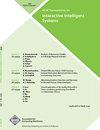动词:可视化和解释的偏见缓解技术的几何字表示
IF 4.8
4区 计算机科学
Q2 COMPUTER SCIENCE, ARTIFICIAL INTELLIGENCE
引用次数: 1
摘要
词向量嵌入已经被证明包含并放大了它们所提取的数据中的偏见。因此,人们提出了许多技术来识别、减轻和减弱单词表示中的这些偏差。在本文中,我们利用交互式可视化来增加可解释性和可访问性的最先进的脱偏技术的集合。为了帮助实现这一点,我们提出了嵌入表示的可视化去偏(“VERB”)系统,这是一个基于web的开源可视化工具,可以帮助用户获得技术理解和视觉直觉的内部工作的去偏技术,重点是他们的几何属性。特别是,VERB提供了易于理解的示例,探索这些去偏技术对高维词向量几何的影响。为了帮助理解各种去bias技术如何改变底层几何,VERB将每种技术分解为可解释的原始转换序列,并使用降维和交互式视觉探索来突出它们对单词向量的影响。VERB旨在针对在词嵌入基础上设计决策系统的自然语言处理(NLP)从业者,以及研究NLP中机器学习系统的公平性和伦理的研究人员。它也可以作为教育的视觉媒介,帮助NLP新手理解和减轻词嵌入中的偏见。本文章由计算机程序翻译,如有差异,请以英文原文为准。
VERB: Visualizing and Interpreting Bias Mitigation Techniques Geometrically for Word Representations
Word vector embeddings have been shown to contain and amplify biases in the data they are extracted from. Consequently, many techniques have been proposed to identify, mitigate, and attenuate these biases in word representations. In this paper, we utilize interactive visualization to increase the interpretability and accessibility of a collection of state-of-the-art debiasing techniques. To aid this, we present the Visualization of Embedding Representations for deBiasing (“VERB”) system, an open-source web-based visualization tool that helps users gain a technical understanding and visual intuition of the inner workings of debiasing techniques, with a focus on their geometric properties. In particular, VERB offers easy-to-follow examples that explore the effects of these debiasing techniques on the geometry of high-dimensional word vectors. To help understand how various debiasing techniques change the underlying geometry, VERB decomposes each technique into interpretable sequences of primitive transformations and highlights their effect on the word vectors using dimensionality reduction and interactive visual exploration. VERB is designed to target natural language processing (NLP) practitioners who are designing decision-making systems on top of word embeddings, and also researchers working with the fairness and ethics of machine learning systems in NLP. It can also serve as a visual medium for education, which helps an NLP novice understand and mitigate biases in word embeddings.
求助全文
通过发布文献求助,成功后即可免费获取论文全文。
去求助
来源期刊

ACM Transactions on Interactive Intelligent Systems
Computer Science-Human-Computer Interaction
CiteScore
7.80
自引率
2.90%
发文量
38
期刊介绍:
The ACM Transactions on Interactive Intelligent Systems (TiiS) publishes papers on research concerning the design, realization, or evaluation of interactive systems that incorporate some form of machine intelligence. TIIS articles come from a wide range of research areas and communities. An article can take any of several complementary views of interactive intelligent systems, focusing on:
the intelligent technology,
the interaction of users with the system, or
both aspects at once.
 求助内容:
求助内容: 应助结果提醒方式:
应助结果提醒方式:


